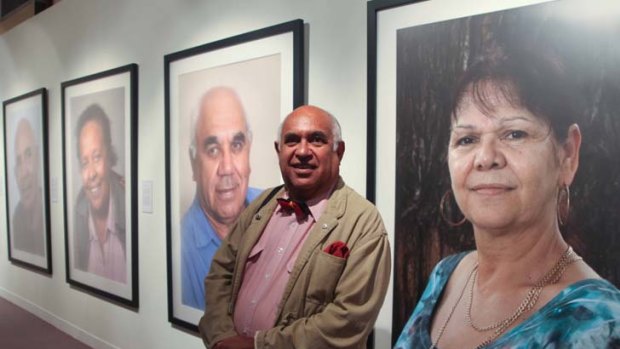By Malcolm Brown
SO OFTEN hidden, the bright, outgoing, laughing face of Aboriginal people is openly displayed in an exhibition of 22 portraits of Aboriginal elders by the photographer Merv Bishop, which was launched at the Australian Museum yesterday.
The exhibition, Sydney Elders: Portraits of Aboriginal and Torres Strait Islander Elders, revealed subjects in a way that is ''completely opposite'' to how so many presented themselves - withdrawn and sullen - said one portrait subject, Shane Phillips.

''The hidden faces of Sydney'' … Merv Bishop views his photographic exhibition of Aboriginal elders at the Australian Museum.Credit: Suellen Symons
''For so long our people have had that perspective of themselves,'' he said. ''But once you get to know them for themselves, they have this sense of belonging and this sense of worth. People just open up and you see this great sense of humour.''
Merv Bishop, born in Brewarrina in July 1945, is the first Aboriginal photographer to work for a metropolitan newspaper. In 1971, he was declared Australian Press Photographer of the Year. The museum commissioned him in December last year to do the present series.
The first photos of Aborigines were taken in 1847 and for most of the history that followed, where the photographers were non-Aboriginal, they were the ''victims'' behind the lenses, the essayist Djon Mundine said.
''Photographers of these times searched for the stereotyped primitive and posed their Aboriginal subjects accordingly,'' he said. ''Ultimately and blatantly, photography became another tool of colonialism, a tool with which to label, control, dehumanise and disempower.''
Millie Ingram, a former adviser to government on community relations, was lined up on the walls with the likes of the great community worker Sol Bellear, the musician ''Uncle'' Vic Sims, Richard Phillips, a former boxer who fought under the name of Dick Blair, and the La Perouse artist Esme Timbery, who specialises in work with shells.
Watching also were Christine Donnelly, founder of the Aboriginal Dance Theatre, at Redfern, Mick Mundine, of the Aboriginal Housing Company, and the one-time angry young man of Moree, Lyall Munro jnr.
The former NSW MLC Meredith Burgmann knew many of those featured from her activist days. ''People have got to come and look at this. They are so strong and confident,'' she said. They were, said Adrian Newstead, the curator of the Coo-ee Aboriginal Art Gallery at Bondi, ''the hidden face of Sydney''.
Merv Bishop, who boarded at a Church of England boys' hostel in Dubbo under a part bursary provided by the Aboriginal Welfare Board with the assistance of a group of Sydney Morning Herald subeditors, joined the Herald in 1963. In 1974 he became photographer for the new Department of Aboriginal Affairs. His first solo exhibition, In Dreams: Mervyn Bishop Thirty Years in Photography, was held in 1991.